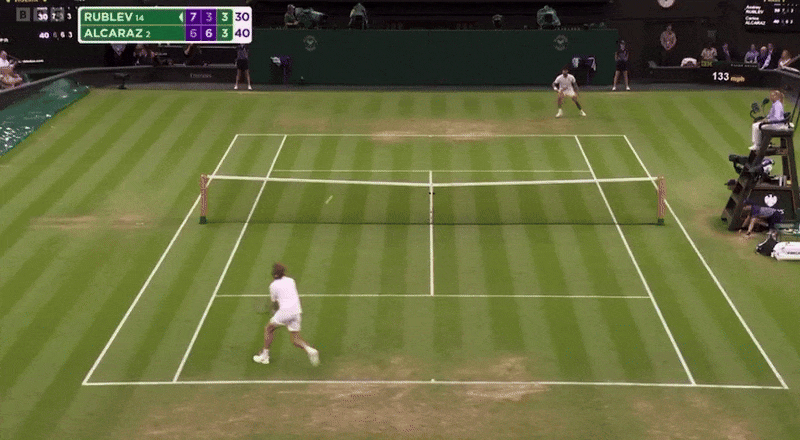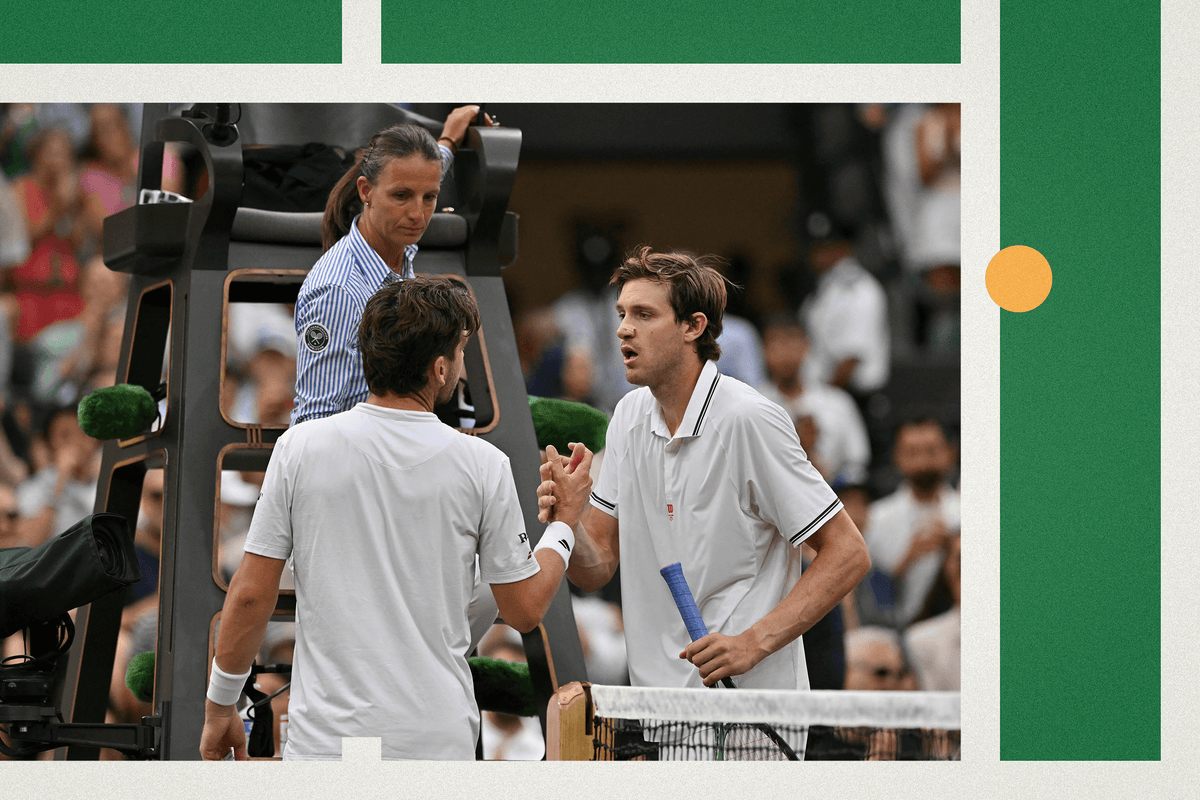Follow The Athletic’s Wimbledon coverage
Welcome to the Wimbledon briefing, where The Athletic will explain the stories behind the stories on each day of the tournament.
On day seven, there was a row over bouncing the ball, two remarkable quarterfinal records and a very in-demand outfit.
What’s in the bounce of a ball?
Chilean qualifier Nicolás Jarry has had a good Wimbledon. He came from two sets down to win his first match against No. 8 seed Holger Rune, knocked out Brazilian phenom João Fonseca and reached the fourth round.
Then, two sets down against Britain’s Cameron Norrie, Jarry cracked. “I just have to suck it because he does it always?” he asked the chair umpire.
Was Norrie shouting in his direction? Giving him death stares? Trying to hit the ball at him?
No. He was bouncing the ball between his first and second serves. Sometimes a little, sometimes a lot. Jarry felt the umpire should intervene, because it was affecting his rhythm, especially when Norrie took a long time.
There is no shot clock between first and second serves, but players are supposed to hit their second “without delay.” They have 25 seconds between points.
Whatever the merits of being rattled by a player bouncing a tennis ball, it fired Jarry up. He came back to level the match, and even tried out some slow ball bounces between his own first and second serve, just to see what it felt like.
Jarry served a double fault, and Norrie — and his ball-bouncing — came through to win, 6-3, 7-6(4), 6-7(7), 6-7(5), 6-3.
Nicolas Jarry tried to play Cameron Norrie at his own game 😬#Wimbledon pic.twitter.com/KNy6fAqgwT
— BBC Sport (@BBCSport) July 6, 2025
Most ball-bounce drama in tennis involves whether a shot has bounced twice before a player hits it. Having such an idiosyncratic reason for aggro is pleasing, if a little overblown — especially as Jarry saw fit to involve Norrie in an elongated conversation when the match was over. Norrie said later that Jarry felt he was too “vocal.” That’s just the way the ball bounces.
James Hansen
Two contrasting quarterfinal feats?
Among the surprise list of players still in the Wimbledon women’s draw, a couple stand out.
Anastasia Pavlyuchenkova, 34 and Laura Siegemund, 37, are tour veterans, but are playing in their second and first Wimbledon quarterfinal respectively. Pavlyuchenkova last played in one nine years ago, and said after beating Britain’s Sonay Kartal that she was as surprised as anyone by her progress here.
“I always thought grass was very tricky for me through my whole career,” Pavlyuchenkova, the world No. 50, said in a news conference. She joked that had she lost, following a malfunction with the electronic line calling (ELC) that cost her a crucial game in the first set, she would “just say, ‘I hate grass and Wimbledon, like usually we always do when we lose.’”
Siegemund, who is ranked No. 104, said after beating lucky loser Solana Sierra that her run this year was overdue. Her slice-heavy game naturally matches up well on grass but she explained that clay is her best surface and she often arrived at Wimbledon tired after that swing: “I always felt on grass that by the time I start to feel the game and I start to play better, it’s already over. That was how it pretty much went every year.”
She has the ultimate test next against the world No. 1 Aryna Sabalenka, while Pavlyuchenkova plays Amanda Anisimova, the No. 13 seed.
Charlie Eccleshare
From Centre Court to history
On the day British women’s player Kartal played her first match on Centre Court, the curators down at the Wimbledon Lawn Tennis Museum were eyeing up her Adidas kit for their collection. A collection which has 40,000 items in it, including 1,000 historic rackets, some of which date back to the 1870s.
“We’ve got some space for the next few years,” senior curator of an ever-growing collection, Emma Traherne, said in an interview.
“Every year we collect between 100 and 200 objects just from the Championships. We collect all year round too.”
Traherne and her team spend a lot of time at auctions each year in search of historic items, but they send letters to players whose kits they want to add to the growing collection. Coco Gauff’s bespoke New Balance dress, which she wore for her first-round defeat to Dayana Yastremska, is among the items to have caught their eye this year.
Kartal’s kit is set for the Wimbledon museum. (Kidril Kudryatrsev / AFP via Getty Images)
The museum attracts 60,000 visitors per year outside the Wimbledon fortnight, but the tournament sees another 40,000 pass through during the two weeks.
“This is like our Super Bowl,” Anna Boonstra, an American fashion historian and curator working at the museum, said. Boonstra, from Chicago, is working on a food and drink exhibition which will launch after the tournament is over. She confirms that Pip, the plush strawberry toy which costs $30 and is sold out online, will most likely be included in that display.
Downstairs among the old rackets, towels and tennis crockery, which are all stored in a temperature-controlled room, sits a collection of artwork and posters. Part of the team’s work also sees them become detectives. One quest is to identify the young woman in a 1928 Alfred West painting.
“It’d be interesting to see if we can work out who she is,” Traherne said, as the courts above played host to sporting moments which will be immortalized below for years to come.
Caoimhe O’Neill
A first meeting in five years that feels well overdue
Taylor Fritz and Karen Khachanov won their fourth-round matches Sunday to set up a quarterfinal showdown Tuesday. It’s their first meeting since 2020.
That’s odd, isn’t it?
Both players have gone deep at Grand Slams and won multiple tour events. But they haven’t bumped into each other on a draw sheet since before the Covid-19 pandemic.
That’s a pretty long time ago.
Their last match took place in the ATP Cup in Australia. Khachanov won 3-6, 7-5, 6-1 in a national team competition that doesn’t exist anymore. It’s now known as the United Cup, and it’s a mixed event. Khachanov won their only other match as well, which occurred just months before in Shanghai.
That sounds about right. Khachanov is largely the player that he was then. He was the world No. 17, with an unsubtle, gritty style, mostly built around power on his serve and forehand and a two-handed backhand filled with solidity.
“Our games are quite similar overall,” Fritz said on Sunday. “We practice all the time, so we’re pretty familiar with each other’s games. But yeah, I improved a ton and have become a much, much better player since the last time we played.”
Indeed, Fritz is a completely different animal. He was No. 31 in the rankings, pretty one-dimensional with his serve and his forehand, and when he ran it often looked like he was about to trip over his feet, especially on grass and clay. This week, there’s a decent chance he will rise from No. 5 to No. 4 in the rankings when they update next Mon. July 14.
“He loves to play on grass, or he showed it,” Khachanov said of Fritz. “He won two titles just now a few weeks ago. So he’s really one of the dangerous players.”
Matt Futterman
Other notable results on day seven
- Fritz (5) got some recompense for playing two five-set matches in his first two rounds. Jordan Thompson, who made an improbable run to the fourth round with a bad back injury, retired hurt. He was down 6-1, 3-0.
- Sabalenka (1) won yet another tiebreak to move into the quarterfinals, beating Elise Mertens (24) 6-4, 7-6(4). She is now 15-1 in tiebreaks in 2025.
- Carlos Alcaraz (2) produced his best performance of the event against Andrey Rublev (14), winning 6-7(5), 6-3, 6-4, 6-4.
Shot of the day
Alcaraz plays points on grass that were barely plausible not that long ago. The movement in this one is simply absurd.

Day eight matches you should actually watch
🎾 Men’s singles: Marin Čilić vs. Flavio Cobolli (22)
6 a.m. ET on ESPN/ESPN+
This is likely to be the most competitive encounter in the men’s matches tomorrow, along with Ben Shelton’s clash with Lorenzo Sonego. Čilić, a former Wimbledon finalist, plays to the grass archetype of see ball, hit ball. Cobolli tries to use more finesse.
🎾 Women’s singles: Mirra Andreeva (7) vs. Emma Navarro (10)
10:30 a.m. ET on ESPN/ESPN+
Rallies, rallies, rallies. Two players who love to redirect, change pace and use the element of surprise — and a rare seed vs. seed clash for this tournament of upsets.
Wimbledon men’s draw 2025
Wimbledon women’s draw 2025
Tell us what you noticed on the seventh day…
(Top photo of Cameron Norrie and Nicolás Jarry: Getty Images; design: Eamonn Dalton / The Athletic)
